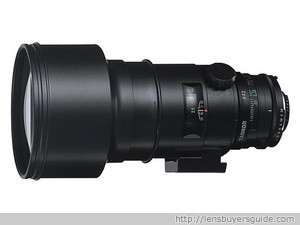Lens finder
Tamron SP AF300mm f/2.8 LD
Full frame sized imageLenses that create APS-C sized image are designed for digital only. They cannot be used on cameras that have image sensor larger than the APS-C format. These lenses are not suitable for film cameras either. No Ultrasonic AFLenses with ultrasonic focusing mechanism tend to be quiter and faster than traditionally focusing lenses. No stepping motor AFLenses with stepping motor focusing mechanism are better for contrast based focusing, and are quiter and faster than traditionally focusing lenses. One or more Low Dispersion lens element is usedLow Dispersion lens elements help to reduce chromatic aberration. Not stabilizedImage stabilization helps to reduce blur caused by hand shake, especially at high focal length or in low light situations. Image stabilization can give 1 to 3 stop advantage over none stabilized lens, based on the reciprocal rule. Metal mountCheaper lenses are usually equipped with plastic mount, while more expensive, professional lenses have metal mount. In general, metal mounts are more durable, and a good thing to have when lenses are changed a lot. When a camera is used mainly with one lens, the material of the lens mount is not that important. Internal FocusingInternally focusing lenses don't change their size while setting focus. The front lens is fixedThe fixed front lens is not rotating during zoom and/or focusing. This allows the photographer to use petal shaped lens hood. Fixed front lenses also make the use of polarization filters a lot easier. Supports drop-in filtersDrop-in filters are used in those lenses where either the front lens is too large, or the field of view doesn't permit the use of traditional filters at the front of the lens. Usually bright tele and ultra-wide angle lenses support this filter type. |
|
|
Tamron's fast telephoto SP AF300mm F/2.8 LD (IF) delivers remarkable and exacting performance demanded by professionals. Two large LD (Low Dispersion) elements in the front lens group provide high contrast and crystal-clear image quality from the full open aperture. With Internal Focusing, you can maintain optimum holding balance since the lens' overall length remains constant during focusing. Our Floating Focusing System improves optical performance especially at close shooting distances. Nine specially-shaped aperture blades form a nearly perfect circle to create excellent background blur for outdoor portraits. The true value of this lens is apparent when photographing sports action, low light theater performances, and wildlife. New is a Canon version that provides an easy-to-use AF/MF focusing ring, rear filter insertion frame that is compatible with the standard accessory circular polarizing filter and with the ring rotation capability from outside the lens, and detachable tripod mounting stand.
|
Tamron SP AF300mm f/2.8 LD Specification
| Available mount(s) | Canon EF, Nikon F, Sony / Minolta A |
| Application(s) | Sports, Wildlife |
| Category(s) | Super telephoto |
| Multiplier | 1× |
| Stabilizer | no |
| Focal length | 300 mm (prime) |
| Lens construction | 10 elements in 7 groups |
| Angle of view |
35mm: 8° digital: N/A |
| Number of blades | 9 |
| Maximum aperture | f/2.8 |
| Minimum aperture | f/32 |
| Minimum focusing distance | 250 cm |
| Magnification | 0.14× |
| Filter size | 43 mm |
| Size | ∅ 120 × 212.5 mm |
| Weight | 2800 g |
| Notes |
|
| AF speed | N/A |
| AF sound | |
| Internal focusing | yes |
| Internal zoom | N/A |
| Fix front lens | yes |
| Mount type | metal |
| Weather sealed | N/A |
| Drop in filter | yes |
| Ultrasonic AF | no |
| Stepping motor AF | no |
| APS-C sized circle | no |
| Low dispersion lens element | yes |
| Hard case | N/A |
| Soft case | included |
| Lens hood |
included printable lens hood |
| Tripod adapter | N/A |
Tamron SP AF300mm f/2.8 LD Reviews
Other reviews
Tamron SP AF300mm f/2.8 LD in the news
- Tamron SP AF60mm f/2.0 Di-II Macro
- Nikkor AF-S DX 85mm f/3.5G ED Micro
- Carl Zeiss Distagon T* 35mm f/2.0 ZF
- Sony SAL2875 28-75mm f/2.8 SAM
- Carl Zeiss Distagon T* 28mm f/2 with EF mount
- Tamron SP AF17-50mm f/2.8 XR Di II VC LD Aspherical
- Carl Zeiss Distagon T* 2,8/21 for EF mount
- Carl Zeiss Distagon T* 3,5/18 ZE
- SIGMA 70-300mm F4-5.6 DG OS
- Nikkor AF-S 16-35mm f/4 G ED VR

